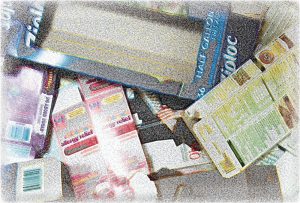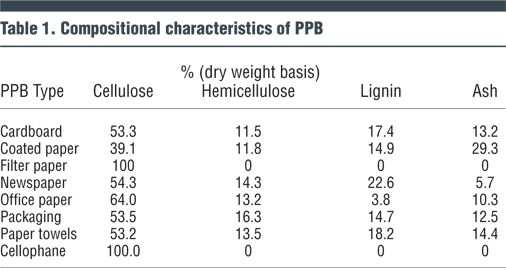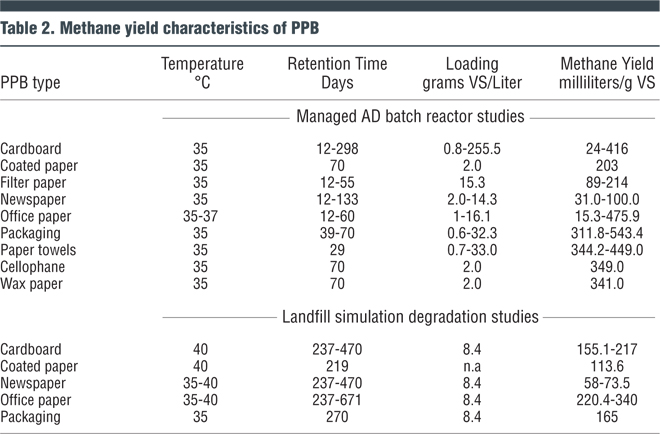Paper and paperboard (PPB) are in the mix of pre and postconsumer feedstocks destined for AD and composting facilities. This overview assesses the digestability of PPB in AD systems.
Craig Coker
BioCycle February 2018
 The Food and Agricultural Organization of the United Nations estimates annual worldwide production of paper and paperboard (PPB) products to be 441 million tons/year. A lot of this PPB ends up in the municipal solid waste stream. In the U.S., 64.7 percent of the PPB generated is recycled, 28.4 percent is landfilled and 6.9 percent is incinerated (U.S. EPA, 2016). PPB can represent up to 30 percent or more of the traditional mixed solid waste stream in the U.S. As food waste recovery and recycling initiatives expand around the U.S., the composting and anaerobic digestion facilities processing those feedstocks will continue to see PPB in the mix of pre and postconsumer feedstocks. This article provides an overview of the digestability of PPB in modern anaerobic digesters.
The Food and Agricultural Organization of the United Nations estimates annual worldwide production of paper and paperboard (PPB) products to be 441 million tons/year. A lot of this PPB ends up in the municipal solid waste stream. In the U.S., 64.7 percent of the PPB generated is recycled, 28.4 percent is landfilled and 6.9 percent is incinerated (U.S. EPA, 2016). PPB can represent up to 30 percent or more of the traditional mixed solid waste stream in the U.S. As food waste recovery and recycling initiatives expand around the U.S., the composting and anaerobic digestion facilities processing those feedstocks will continue to see PPB in the mix of pre and postconsumer feedstocks. This article provides an overview of the digestability of PPB in modern anaerobic digesters.
PPB is typically fabricated by processing wood through a series of mechanical and chemical steps. They are composed of cellulose, hemicellulose and lignin (lignocellulose). Cellulose, the main structural component of plant cell walls, is a linear polymer consisting of thousands of glucose residues arranged in a rigid, crystalline structure. Layers upon layers of cellulose-containing microscopic fibers (known as microfibrils) give plant cell walls their remarkable strength. Each microfibril consists of a crystalline cellulose core encased within an outer layer of polysaccharides known as hemicellulose. Cellulose and hemicellulose are considered structural carbohydrates (Gonzalez-Estrella, 2017).
The anaerobic digestion (AD) of lignocellulosic materials is commonly limited by the hydrolysis step due to the complex structural and chemical mechanisms in plants for resisting assaults on plant structural sugars from the microbial and animal kingdoms (Himmel, 2007). As papermaking alters the composition and structure of the lignin in the woody source materials, it may also affect its anaerobic biodegradability.
Factors that affect the compostability and digestability of lignocellulose and crystalline cellulose include its high molecular weight, lack of solubility, hydrophobicity and strong interchain bonding. This is why composting (and digestion) recipes need to be adjusted for the lignin content of woody and PPB materials in the feedstocks. The biological enzymes used to break down feedstocks in the initial step of hydrolysis in AD need physical access to the structural carbohydrates in cellulose. However, the lignin, hemicellulose, and ash can physically protect cellulose fibers. Pretreatment of AD feedstocks with heat and pressure can alter some of those physical protection mechanisms, allowing faster hydrolysis and better methane yield.
Pulping, Impacts On Digestability
The generic steps in the papermaking process include: 1) Pulping, to separate and clean the fibers; 2) Beating and refining the fibers; 3) Diluting to form a thin fiber slurry, suspended in solution; 4) Forming a web of fibers on a thin screen; 5) Pressing the web to increase the density of the material; 6) Drying to remove the remaining moisture; and 7) Finishing, to provide a suitable surface for the intended end use (U.S. Congress, 1989).
Pulping is an important step from the AD perspective because of its effect on the structure and composition of the wood matrix. The goal of pulping is to refine the wood fibers so they will cohere into a sheet, with minimal loss of structural strength. The type of pulp obtained by the pulping process determines the structure of the final product, including lignin content, fiber morphology, and degree of bonding in the cellulose matrix. The two types of pulping processes are mechanical and chemical. Mechanical pulping is like wood grinding; it is maceration of the wood fibers but under high temperature to disrupt the lignin structure. This breaks the cellulose fibers in the process, producing a structurally weaker product. Chemical pulping dissolves the lignin and hemicellulose, which results in stronger paper with less pigmentation.
Beating, or refining, is often used to improve the mechanical strength of chemical pulps by improving fiber-to-fiber bonding. Solubilization of the organic matter in PPB is the first step in the AD hydrolysis process, so greater cohesion and strength could result in slower hydrolysis during AD. Bleaching removes some of the pigmentation remaining after pulping. Typically, when chemical pulps are bleached, residual lignin is further removed whereas when mechanical pulps are bleached, lignin is conserved but converted to a colorless form. As lignin is recalcitrant in AD systems, paper made of bleached chemical pulps should have a higher biogas yield than paper made of mechanically pulped wood fibers.
Various additives are used in papermaking for texture, brightness or pH control. The majority of the printing and writing papers are manufactured neutral to alkaline using some amount of calcium carbonate filler, at a buffered pH of 7.8 to 8.2. Methanogens are sensitive to pH, so the additional alkalinity from PPB could reduce the potential inhibitory effects of acid accumulation. Clays, another common filler in paper used for magazines like BioCycle, have been shown to decrease ammonia toxicity in AD systems, via absorptive or ion-exchange mechanisms.
Anaerobic Digestion Considerations
Composition Of PPB
Understanding the composition of PPBs may be a useful indicator of their potential suitability as an AD substrate. Table 1 lists the average compositional results of 29 different analyses reported in the literature.
Newspaper has more lignin in it and office paper has much less. Coated paper has more additives (the ash content is higher) and newspaper has much less.
Biogas Potential Of PPB
Numerous batch AD tests of PPB, for both managed AD systems and for landfill gas generation, have been reported in the literature. Average methane yields reported are shown in Table 2. The retention times for the batch tests reflect the relative recalcitrance of PPB to AD; most required 20 to 70 days. The very long retention times reported (237-671 days) were associated with landfill biogas studies. Retention times in managed AD reactor studies are often chosen as a balance between too short (and subsequent failure to stabilize waste) and too long (with resultant expansion of reactor volumes and costs). In landfill gas simulation studies, retention times are chosen to reflect various assumptions about the longevity of gas generation in the landfill.
Office paper, packaging, paper towels, wax paper and cellophane had the highest methane yield potentials reported (average of 322–394 mL/g VS), while cardboard, coated paper and filter paper had lower yields (average of 152-210 mL/g VS) and newspaper had low yields (average of 77 mL/g VS). By comparison, batch AD tests on food wastes at 50°C demonstrated yields of 348 mL/g VS after 10 days and 435 mL/g VS after 28 days (Zhang, 2007). Batch AD tests on partially dewatered fats, oils, and greases (FOG) at 35°C demonstrated yields of 1,010 mL/g VS after 23 days (Kabouris, 2008).
Pretreatment Of PPB
Pretreatment of PPB is performed to increase the methane yield by degrading or removing lignin and by hydrolyzing cellulose and hemicellulose. Methods reported in the literature include wet oxidation, hydrothermal treatments, and microbial processing. Wet oxidation involves subjecting PPB to high temperature and pressure to physically disrupt and chemically oxidize lignin and cellulose. Hydrothermal treatments involve high pressure steam and addition of lignin-removal chemicals like sodium hydroxide and hydrogen peroxide. Microbial processing is a less chemically intensive method of pretreatment using cultured microbes from the first stomach (rumen) of a ruminant like cattle. Research into these various pretreatment steps showed varying results, so it remains unclear whether there is economic justification for pretreating PPB.
Codigestion With Other Substrates
Codigestion of multiple substrates often generates better methane yields than digestion of a single substrate. The prevalence of PPB in the solid waste stream and its relatively slow degradation rates makes it suitable for codigestion with many other substrates. Most of the research reported some degree of yield improvement when PPB was codigested, but the inherent recalcitrance of PPB to digestion can decrease the overall rate in the reactor. This can be a useful property if the cosubstrate is prone to inhibition by ammonia or volatile fatty acids. Several researchers have reported process improvements in digesters codigesting PPB due to the increase in carbon:nitrogen (C:N) levels.
Future Research Needs
Several areas of future research needs have been proposed, including:
• Better understanding of the role of crystalline cellulose and polymerization on suitability of PPB in AD
• Role of the microscopic structure of PPBs inhibiting hydrolysis
• Nature of the interactions between anaerobic microbes and PPB surfaces
• Greater insight into the economic cost-benefit of pretreatment
• Improved characterization of the microbial communities in continuous digesters and their effect on PPB
• Life cycle and economic assessments of collection, hauling and sorting to facilitate assessments of AD versus composting versus incineration
Craig Coker is a Senior Editor at BioCycle and CEO of Coker Organics Recycling near Roanoke, VA. He can be reached at ccoker@jgpress.com.












